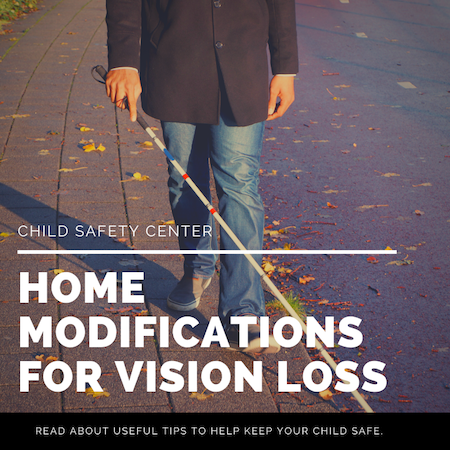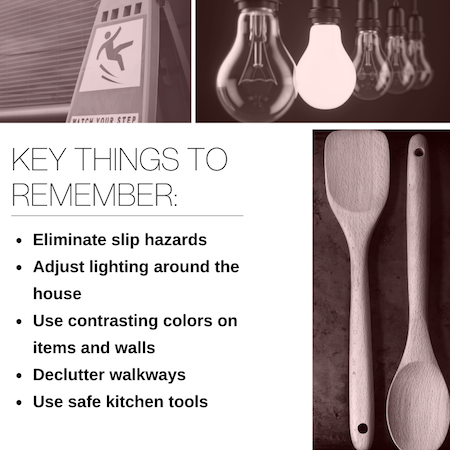Home Safety for Children With Vision Loss
If you have a child that’s affected by vision loss, you might be wondering how they will be able to safely move around the house. An average house can be filled with several different types of hazards to someone who can’t see. Fortunately, there are several steps you can follow to make your home a safe place for anyone with vision impairment. We’ve broken down our suggestions room by room to cover as much as possible. As you read over our list, make sure to think about the way your child behaves. You know which room they like to be in and what things they like to get into, so use your best judgment while proofing your house.
General Safety Suggestions for Vision Loss- Try different types of lighting to see which one works best for your child.
- Remove any rugs around the house, as they can curl or slip and cause a fall.
- Reduce clutter as much as possible and keep halls clear.
- Avoid having patterned carpets.
- If you keep a telephone at your house, get one with large, easy to read numbers.
- Keep a list of important numbers near the phone.
- Make sure to keep internal doors either completely open or completely shut.
- Keep electrical cords away from walkways.
- Cover wall outlets with contrasting colors to keep your child from sticking their fingers near it.
- Use lighting that is 60-100 watts.
- Avoid having any low hanging lamps.
- Keep items away from the edges of tables or near corners.

- Use contrasting colors in the room. For example, if the walls are painted a light color, use a dark color for towels and washcloths. This makes it easier to distinguish.
- Install railing in the bath and shower to help your child stay safe when getting in or out.
- Use a chain to connect the bathplug to the tap.
- Use non-slip mats on the floor to avoid falls.
- Tie soap attached to the grab rail for easy access.
- Use electric shavers compared to regular razors.
- Use nail clippers or nail files instead of scissors.
- Install a night light in the hallway towards the bathroom to have a path to the bathroom at night.
- Install a special toilet seat with handles that can assist in getting up or down.
- Use kitchen cutters instead of knives to open plastic packets.
- Wash knives with a long-handled brush to stay safely away from the blade.
- Use vegetable and cheese slicers to cut food.
- Keep saucepan handles turned away from people to prevent an accident.
- Always use flame retardant oven mitts when handling hot material and keep a fire safety blanket in the kitchen.
- Keep the clothesline above your child’s height and use padding on the corners.
- Use cotton gloves whenever you need to use an iron around your child to reduce the risk of burns.
- Pin socks together with sock locks before putting them away.
- Use dividers for drawers and closets to separate clothing.

- Attach non-slip contrasting color strips to the side of steps and stairs.
- Install railings.
- Attach labels to cleaning and toxic products to make them easy to identify, and keep any flammable items away from the kitchen.
- Use brightly colored tags with large print labels to distinguish different types of medications.
- Use a pill container with separate days of the week.
- Mark the usual dosage level on the medicine cup.
With the right adjustments, you can make your home very easy to navigate for your vision impaired child. They key points to remember are: eliminate trip or slip hazards, adjust lighting around the house, use contrasting colors on items and walls, declutter walkways, and use safe kitchen tools. You can also ask your child if there are any specific needs they have that will help make navigation easier for them. Try scooting furniture closer together so it’s easier to interact with each other as a family.
Sources and Additional LiteraturePogrund, R. L. (2018). Accommodations and Modifications for Individuals with Visual Impairments: Too Many or Not Enough?. Journal of Visual Impairment & Blindness, 112(3), 299-301.
Berger, S. (2012). Is my world getting smaller? The challenges of living with vision loss. Journal of Visual Impairment & Blindness, 106(1), 5-16.
Vladutiu, C. J., et al. (2012). Disability and home hazards and safety practices in US households. Disability and health journal, 5(1), 49-54.
Riazi, A., et al. (2012). Home modification guidelines as recommended by visually impaired people. Journal of Assistive Technologies, 6(4), 270-284.
Keeffe, J. (2004). Childhood vision impairment.
Duffy, M. A. (2002). Making life more livable: Simple adaptations for living at home after vision loss. American Foundation for the Blind.

